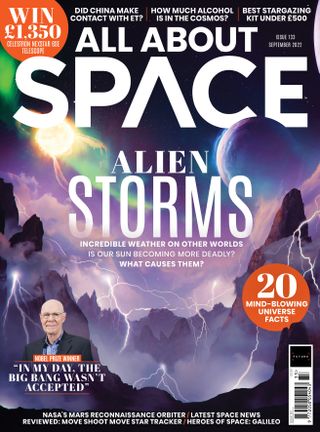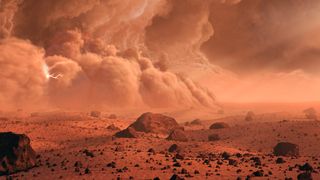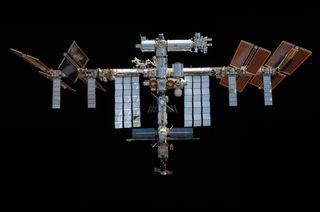Explore the weirdest weather in the solar system with All About Space magazine
Uncover the science behind alien storms.

Inside All About Space issue 133, on sale now, you can explore the weirdest weather in the solar system, including space weather events influenced by our angry, stormy sun.
All About Space investigates these strange alien storms, looking at how they form and the science behind them. From dust storms that blanket a planet to winds that travel twice the speed of sound, the solar system plays host to some seriously bizarre weather phenomena.
The latest issue also includes a Q&A with American radio astronomer and Nobel Prize winner Robert Woodrow Wilson on how the discovery of radiation left over from the heat of the Big Bang caused a revolution in cosmology.
Related: 10 extraordinary ocean worlds in our solar system

Get All About Space delivered straight to your door or digital device. Subscribe to All About Space from $8.50 per quarter/three issues.
Elsewhere in this issue, you'll find 20 amazing facts about the universe. From the size of hypergiant stats to the weird effects of space travel on the human body, prepare to have your mind blown by the awesome cosmos we live in.
All About Space also takes a look at the Mars Reconnaissance Orbiter (MRO) and how it has influenced the field of astronomy.
The magazine also explores space stations' past and present and uncovers the history and geopolitics behind the orbital laboratories.
Get the Space.com Newsletter
Breaking space news, the latest updates on rocket launches, skywatching events and more!





You can also find a detailed stargazer section filled with useful information on what to look out for in the night sky. This issue also brings you backyard astronomy on a budget which includes tips on how to enjoy all the fun of astronomy without breaking the bank.
Take a peak at All About Space issue 133's biggest features below.
Alien storms

We know our sun as a brilliantly bright sphere that rises in the east and sets in the west each day. That's a simple way to describe it; what really occurs on its surface is far from the impression it gives as it hangs, almost calmly, in the daytime sky. While going near the sun would be suicide, with the searing heat and penetrating radiation combining to fry you alive in your spacesuit, technology has revealed this star to be an angry, bubbling cauldron of solar activity.
First up are solar flares — bursts of radiation from the sudden release of magnetic energy from active regions on the sun's surface, the photosphere. These regions are centered on sunspots, which are tangled knots of magnetic fields. The flares release as much as a sixth of the total amount of energy that the sun releases every second, with much of it in X-rays or ultraviolet light. The energy of a flare can drive a cloud of charged particles to escape the solar corona in a coronal mass ejection (CME). The CME becomes a giant cloud of plasma hurtling through space and, when CMEs are pointed towards Earth, they cause solar storms.
Read the full feature in the latest All About Space.
How many types of space station are there?

The first description of a space station appeared in a short story, The Brick Moon, written in 1869 by American author Edward Everett Hale. It is also thought to be the first description of an artificial satellite, and satellite navigation, as a 200-foot (61-meter) wide brick sphere is launched into orbit as a navigational aid. However, Russian scientist Konstantin Tsiolkovsky carried out the first scientific work on space stations in the early 20th century. Slovenian scientist Herman Potočnik then put forward the classic rotating ring-shaped design in his 1929 book, The Problem Of Space Travel. Ultimately, it would be the USSR that launched the first real space station, which was Salyut 1 in 1971.
The Salyut program grew out of studies from the 1960s for military reconnaissance stations called Almaz; they gained new priority when the US beat the USSR to the Moon and the Soviet program searched for a new focus.
Read the full feature in the latest All About Space.
Did Chinese scientists really contact aliens?

They say that in space, nobody can hear you scream. But if you listen very carefully, you may be able to pick up signs of distant chatter from extraterrestrial civilizations. That appeared to have happened recently when astronomers at Beijing Normal University issued a statement in Science and Technology Daily, the official newspaper of China's Ministry of Science and Technology, which reported the possibility of having detected trace signals from aliens.
Yet, just as researchers (and the general public) around the world were beginning to digest the news with interest, the statement was removed. A conspiratorial cover-up? Not quite. "The Chinese report of signals is — in my opinion — very likely to simply be radio frequency interference, from orbiting satellites most probably," says Dr Seth Shostak, senior astronomer at the SETI Institute in California. "I think the Chinese have said something similar themselves." Indeed they have. But what the initial report showed was just how wide the ongoing efforts to communicate with intelligent alien life have become.
Read the full feature in the latest All About Space.
Join our Space Forums to keep talking space on the latest missions, night sky and more! And if you have a news tip, correction or comment, let us know at: community@space.com.

Daisy Dobrijevic joined Space.com in February 2022 having previously worked for our sister publication All About Space magazine as a staff writer. Before joining us, Daisy completed an editorial internship with the BBC Sky at Night Magazine and worked at the National Space Centre in Leicester, U.K., where she enjoyed communicating space science to the public. In 2021, Daisy completed a PhD in plant physiology and also holds a Master's in Environmental Science, she is currently based in Nottingham, U.K. Daisy is passionate about all things space, with a penchant for solar activity and space weather. She has a strong interest in astrotourism and loves nothing more than a good northern lights chase!